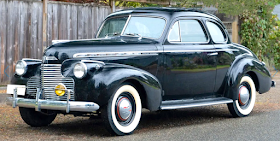This magazine-format paperback book was published in 1976. The author is Paul R. Woudenberg, Ph.D., a noted automobile historian who I once saw handling the microphone at the awards session at the annual Pebble Beach Concours.
On a photo caption on Page 131 Woudenberg stated "It is the general opinion of car enthuiasts today, be they Chevrolet buffs or not, that the 1941 Chevrolet was far and away the very best model of this GM Division."
I'm inclined to agree, even though I have a soft spot for '55 Chevys. Today's post is intended to place '41 Chevy coupes in the context of 1940 and 1942 equivalents.
Sources of images below: 1940 - car-for-sale; 1941 - Mecum Auctions; 1942 - BaT Auctions.
Brochure image of 1941 Special DeLuxe coupe
Chevrolets were given General Motors' new A-body platform for 1941.
1940 Chevrolet Special DeLuxe Coupe
The previous A-body was less sleek. Worse, although GM was the usual American styling leader in those days, its treatment of headlight assembly design was retrograde. Brands where headlights were integrated into front fenders in 1940 were Plymouth, Dodge, DeSoto, Chrysler, Ford, Mercury, Lincoln, Hudson, Nash, Studebaker and Willys. Only the dying Hupp and Graham brands along with conservative Packard retained non-integrated headlights along with GM.
1941 Chevrolet Special DeLuxe Coupe
Continuity touches with minor variations from 1940 included the upper side chrome strip and the grille profile. Headlights are nearly embedded in front fenders. Overall body shaping is more integrated, more rounded. Wheelbase was increased three inches (76 mm) to aid those changes.
Setting aside the shorter wheelbase, the passenger compartment greenhouse is rather short lengthwise, giving an upright, not-very-streamlined profile.
For some reason, this for-sale car rides higher than normal (and as seen in its previous image). That aside, the body profile is smoother, more streamlined-looking. Fenders are more integrated with the main body, a continuation of the main car design trend of the 1930s. The better-integrated headlight assemblies assist in this.
The 1940 coupe seems tall from this perspective. Even so, shaping is smoother than coupe designs of a few years earlier.
The rear design is not radically different from 1940. Still, the major shapes are more similar to one another than before -- especially the after part of the greenhouse and the trunk lid. Note the running board is narrower and covered by sheetmetal, yet another integrating touch.
1942 Chevrolet Special DeLuxe Coupe
Showing how the 1941 design was facelifted for the war-shortened 1942 model year. Same basic body as for '41, but important frontal changes. The grille profile/framing is simplified. Headlights are integral with the fender design. And front fenders are extended across the doors -- a feature found in nearly all '42 GM cars.
Not much change at the rear. Those extended front fenders are an evolutionary step towards flow-through fenders appearing in the late 1940s. But their size makes them seem too heavy, unbalancing the 1941 design. Which is why I consider 1941 Chevrolets better design that Chevys of adjacent (and beyond) model years.










No comments:
Post a Comment